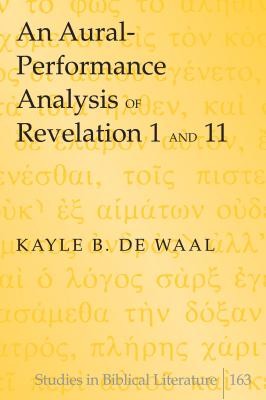
- We will send in 10–14 business days.
- Publisher: Peter Lang Inc., International Academic Publishers
- ISBN-10: 1433130033
- ISBN-13: 9781433130038
- Format: 15.2 x 22.9 x 1.4 cm, hardcover
- Language: English
- SAVE -10% with code: EXTRA
An Aural-Performance Analysis of Revelation 1 and 11 (e-book) (used book) | bookbook.eu
Reviews
Description
This book breaks fresh ground in the interpretation of the Apocalypse with an interdisciplinary methodology called aural-performance criticism that assesses how the first-century audience would have heard the Apocalypse. First-century media culture is probed by assessing the dynamics of literacy, orality, aurality, and performance in the Gospels, parts of the Pauline corpus, and also Jewish apocalyptic literature. The audience constructs of informed, minimal, and competent assist the interpreter to apply the methodology. Sound maps and an aural-performance commentary of Revelation 1 and 11 are developed that analyze aural markers, sound style, identity markers, repetition, themes, and the appropriation of the message by the audience. The book concludes by examining the sociological, theological, and communal aspects of aurality and performance and its implications for interpreting the Apocalypse.
EXTRA 10 % discount with code: EXTRA
The promotion ends in 10d.08:23:25
The discount code is valid when purchasing from 10 €. Discounts do not stack.
- Publisher: Peter Lang Inc., International Academic Publishers
- ISBN-10: 1433130033
- ISBN-13: 9781433130038
- Format: 15.2 x 22.9 x 1.4 cm, hardcover
- Language: English English
This book breaks fresh ground in the interpretation of the Apocalypse with an interdisciplinary methodology called aural-performance criticism that assesses how the first-century audience would have heard the Apocalypse. First-century media culture is probed by assessing the dynamics of literacy, orality, aurality, and performance in the Gospels, parts of the Pauline corpus, and also Jewish apocalyptic literature. The audience constructs of informed, minimal, and competent assist the interpreter to apply the methodology. Sound maps and an aural-performance commentary of Revelation 1 and 11 are developed that analyze aural markers, sound style, identity markers, repetition, themes, and the appropriation of the message by the audience. The book concludes by examining the sociological, theological, and communal aspects of aurality and performance and its implications for interpreting the Apocalypse.


Reviews